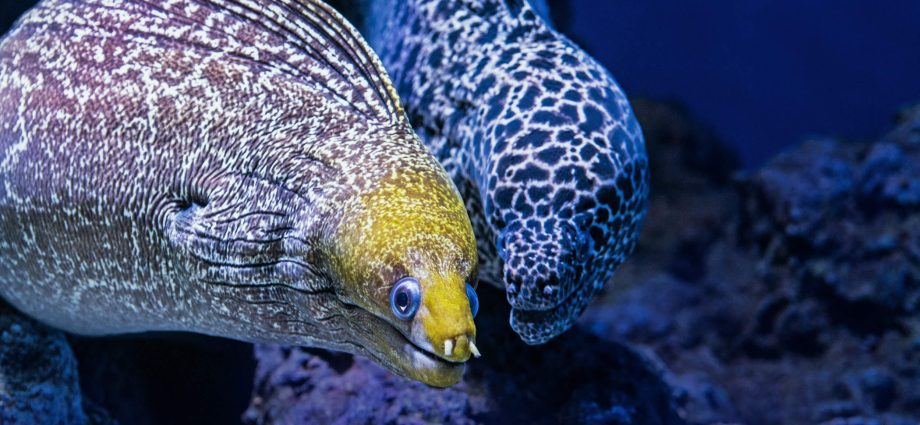Contents
Moray eels belong to the eel-like order. The moray family has about 90 species, according to some other sources there are more than 200 of them. Species are known that can live not only in sea salt, but also in fresh water. The distribution area captures the tropical and, in part, the temperate zone. The appearance of moray eels is quite frightening. They have a massive head with a large mouth and an elongated snake-like body. There are large, sharp teeth on the jaws, the gill covers are reduced, and instead of them there are small holes on the sides of the head. The body of moray eels is covered with a layer of mucus, which protects the fish, but can be dangerous to others. From contact with some types of moray eels, chemical burns can form on the skin of a person. The location of the teeth and the oral apparatus in general are quite complex and are specialized for hunting in cramped conditions of rocks. The bite of moray eels is also quite dangerous for humans. Moray eels differ from most fish in the absence of pectoral fins, and the dorsal and caudal formed one fin fold. Coloring and sizes vary greatly. Sizes can be from a few centimeters to 4 m. A giant moray eel can reach a weight of more than 40 kg. The color is associated with lifestyle and is protective, although some species can be considered quite bright. Pisces are very gluttonous and aggressive, they are distinguished by an unpredictable disposition. Many scientists have repeatedly noted the presence of a certain level of intelligence in these fish, in addition, the habits of fish are known when they selectively treat certain types of animals with which they entered into symbiosis and do not hunt them. They lead an ambush lifestyle, but they can attack their prey from a fairly large distance. Moray eels feed on various inhabitants of the bottom layer, crustaceans, medium-sized fish, echinoderms and others. Most species live at shallow depths, so they have been known to man since ancient times. The main habitat of moray eels is various reefs and coastal underwater rocks. Does not form large clusters.
Ways to catch moray eels
The inhabitants of the Mediterranean have been catching moray eels since ancient times. Because of their appearance, moray eels are described in various terrible legends and myths of the coastal peoples. At the same time, fish are actively eaten. Fishing on an industrial scale is not carried out. Catching moray eels is quite simple. When fishing from a boat, any simple vertical rig using natural baits will do. In addition, for successful fishing it is necessary to lure fish with bait in special feeders.
Catching moray eels on bottom fishing rods
Catching moray eels, despite its simplicity, requires certain skills and knowledge about the habits of fish. In the northern Mediterranean, such fishing is quite popular and widespread. For this, various bottom fishing rods are used. One of the options may be based on relatively long, up to 5-6 m, “long-cast” rods. The weight characteristic of blanks can correspond to 200 g or more. Reels should have large spools to accommodate thick lines. Most anglers who love to fish for moray eels prefer rods that are quite stiff. It is believed that moray eels have very strong resistance, and in order for it not to tangle the tackle, it is necessary to force the fight. For the same reason, tackle is equipped with thick monofilament (0.4-0.5 mm) and powerful metal or Kevlar leashes. The sinker can be installed both at the end of the tackle and after the leash, in a “sliding” version. In the case of fishing in shallow water, it is better to choose evening and night time. If you fish in deep holes, for example, “in a plumb line”, away from the coast, then you can catch it during the day.
Baits
The bait can be a live small fish or sliced uXNUMXbuXNUMXbmeat of marine life. The bait must be fresh. Various small sardines, horse mackerels, as well as small squids or octopuses are suitable for this. For cutting, the meat of any shellfish or sea urchins is quite suitable.
Places of fishing and habitat
Moray eels are inhabitants of the tropical and temperate, coastal zone of the seas of the World Ocean. Found in the Indian and Atlantic Oceans. Widely distributed in the Mediterranean and Red Seas. They usually live at depths of up to 30 m. They lead an ambush lifestyle, hiding in rock crevices, in reefs, and also in artificial underwater structures. During the hunt, they can sail far enough from the ambush site.
Spawning
During spawning, moray eels form large clusters, which is practically never found in ordinary life. Sexual maturity occurs at the age of 4-6 years. Fish are known to have a similar larval developmental cycle to that of eels. The larva is also called leptocephalus. In addition, some species of moray eels are known to be hetmaphrodites that change sex during their lives. Most species are dioecious.










